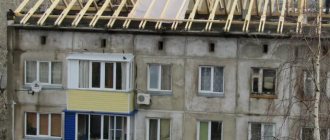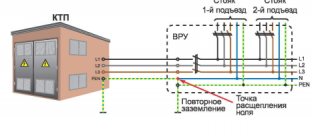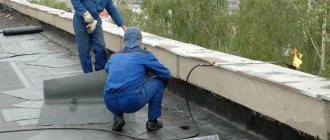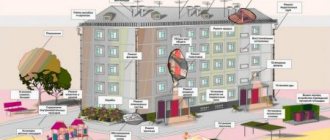When can citizens demand it?
The main goal of regional programs for the reconstruction of houses, operating at the state level, is to prevent the transfer of existing housing into the category of emergency and unfit for habitation.
So, each building corresponds to a specific date. The government contractor is obliged to provide the owners of the premises with the following information 6 months before the start of a major renovation of the façade:
- list of planned works;
- relevant documentation;
- start date;
- deadlines.
Next, members of the asset group (owners of the premises) decide at a meeting whether the house needs major repairs and consider the possibility of carrying out such work. They provide their decision in the form of a protocol and statement to the representative of the contractor.
What to do if major repairs are needed sooner
If apartment owners believe that it is advisable to carry out major repairs ahead of schedule, they have the right to demand that it be carried out ahead of schedule.
Early overhaul of the building
When the amount in the fund does not cover all costs, the owners collect additional contributions. If there are enough funds, then the next step is to contact the management organization. It is she who initiates the creation of the commission and instructs the state contractor to draw up all the necessary documentation.
Who is responsible for the condition of the façade of the MKD?
As stated in clause 1 of Article 158 of the Housing Code of the Russian Federation, the owner of the apartment is obliged to bear the costs of maintaining the premises that belong to him, to maintain the optimal condition of the common property in the apartment building in proportion to his share in the right of common ownership. To do this, he pays a fixed fee monthly. This rule also applies to owners of non-residential premises in the house.
If a company manages the property of an apartment building on the basis of a contract, it is responsible for the proper maintenance of the facade. As for who repairs the façade, if the building has an HOA, as a rule, residents turn to a contractor for services.
In the context of this topic, it is useful to find out what the rights and responsibilities of an HOA are.
To initiate actions of the management company, you need to send an appeal addressed to the director of the organization. The letter should argue for the need to improve the external elements of the building.
Many legal acts of varying legal force regulate the rights and obligations of apartment owners and the management company.
Organizational measures for carrying out major repairs are listed in Federal Law No. 271-FZ in the Housing Code of the Russian Federation dated. According to this document, the constituent entities of the Russian Federation provide for different methods of financing major repairs.
The provisions of the following regulations should also be taken into account:
- Art. 166-174 LCD. They indicate general requirements for carrying out major repairs in apartment buildings.
- Civil Code (Article 210 on the burden of maintaining property).
- Town Planning Code.
- Government Decree No. 615 dated .
The listed documents are intended to regulate the interaction between apartment owners and regional authorities. Thus, Government Resolution No. 615 indicates what work is included in the overhaul, defines the obligations and responsibilities for their implementation.
Territorial authorities are entrusted with organizational and control functions. The owners are required to raise funds to pay for the work.
General information
Renovations are primarily aimed at restoring the original characteristics of the property and improving its appearance.
The overhaul of the facade can be divided into three stages:
- Preparatory work. Within their framework, the old coating is dismantled, fungal formations are removed, as well as contaminants from the surface. The seams are treated, cracks are eliminated and plastering is done again.
- Finishing work. This includes applying a new layer of finishing, such as stone, paint, tile or decorative plaster. At this stage, it is possible to install a ventilated facade.
- Replacement or restoration of functional elements. If necessary, work is carried out to restore canopies, partitions, double-glazed windows, gutters, and other components of the façade of the property.
What is the difference between a major overhaul and a current one?
Distinctive features of major and cosmetic repairs are presented in the table:
| Type of repair | Peculiarities |
| Capital | It is distinguished by a large volume of work, including: · completely removing the old coating from the surface; · clean the surface from rust, fungal infections, salt stains, dust, etc.;
· sometimes they perform a complete replacement of windows, doors, ebbs, drainpipes and other elements of the building. Work during a major renovation of a building is aimed at completely restoring or giving a new look to the house. |
| Cosmetic | Helps maintain the building in good condition. Includes:
Not only is the appearance updated, but the structures are also protected from destruction during operation. |
Facade restoration work varies depending on the degree of its destruction. Regulatory documents establish a repair interval of 5 years for routine repairs and 10 years for major repairs.
When is a major façade renovation necessary?
In most cases, damage to the facade is noticeable to the naked eye, but a full visual inspection is carried out by a commission with the participation of specialists, management company employees and residents of the apartment building. If we are talking about major repairs, representatives of the regional operator are involved. To identify hidden shortcomings, instrumental research is needed.
Obvious signs that indicate the need to restore the facade:
- the plaster layer is damaged or falls over an area of more than 30%;
- seams are visible between blocks/panels;
- the insulation layer cracks;
- gutters are deformed;
- precipitation accumulates on the outer wall.
If the above symptoms are detected, repair work must begin as soon as possible.
Find out more about the range of work included in the major renovation of apartment buildings.
What to do if major repairs are needed sooner?
If the owners consider that some structures are subject to immediate restoration, then they can proceed without waiting for the planned date, but this raises the big question of financing .
For these unscheduled works, it will be necessary to collect additional contributions in addition to those approved as mandatory (Article 189 of the Housing Code).
Payments will be adjusted, so that for a certain time, residents who have spent on additional repairs will be exempt from paying contributions.
In addition to funds, design and estimate documentation is also needed , and someone else should be closely involved in this. To resolve these problems, you should contact your management company, which works with local authorities and the Regional Operator on behalf of residents.
The local administration body, on the basis of an agreement signed between it and the operator, entrusts the latter with the preparation of the project and the organization of the examination. In accordance with the work schedule, within the time limits specified in this schedule and in the contract, work is carried out to overhaul the common property of the residents.
For useful tips on design and estimate documentation, watch the video below:
How is the need for major façade repairs determined?
The main document that serves as the reason for the start of a major renovation of the facade of an apartment building is the official conclusion of the special commission.
Its participants are:
- government contractor;
- authorized employee of the management organization (authority);
- active members from among the owners appointed at the general meeting.
After checking and analyzing all the damage, the commission decides whether major repairs are needed or whether it is permissible to limit ourselves to only superficial restoration. This decision is not based only on one’s own convictions, but must comply with regulatory documents.
Major repairs of an apartment building are carried out with the permission of the commission
So, major repairs are carried out if:
- the insulation is worn out or the seams between the slabs are broken, which affects the penetration of moisture onto the load-bearing wall;
- 35% of the external walls contain destruction of the external cladding;
- The drainage system is broken.
Based on the results of the inspection of the external walls, the commission brings up for discussion what capital work needs to be carried out depending on the nature and extent of the damage.
Overhaul contractor
The restoration of the façade as part of a major overhaul is carried out by a contractor, also called a regional operator. The organization must not be commercial. The company is created by local government authorities for the purpose of implementing a repair program, in accordance with Federal Law No. 255).
The operator is not required to perform the work independently. He can only coordinate them, control payment, quality and deadlines.
Regulatory acts
Organizational measures for carrying out major repairs are regulated by Federal Law No. 271-FZ in the Housing Code of the Russian Federation dated December 25, 2012. The norms provide for the creation in the constituent entities of the Russian Federation of mechanisms for financing major repairs in apartment buildings.
Art. 166-174 LC define the general provisions for major repairs in MKD.
Article 174. paragraph 2. Funds transferred to the capital repair fund can be used:
- to pay for repair and restoration work or services;
- payment for the preparation of estimates and design documentation.
If the commission recognizes the house as unsafe and subject to demolition or reconstruction, the funds are used to pay for these works, and the unspent balance is returned to the apartment owners in parts proportional to the amounts deposited into the current account.
Who should be responsible for painting the facade of an apartment building?
The facade is the calling card of an apartment building and an integral part of the city’s architecture. To avoid the gradual destruction of walls under the influence of external factors, the facade is painted. Applying an external decorative coating not only improves the appearance of the structure, but also helps prevent the leaching of cement between the brickwork. In addition, painting increases the thermal efficiency of the house and is considered reliable protection against fungus and mold. Over time, the applied paint crumbles, then the question arises: “Who should paint the facade and at whose expense is such work carried out?” Let's try to figure out this problem.
How to choose material?! Comparison of insulation materials
Basalt wool has the highest performance characteristics. But it is hygroscopic, so without proper waterproofing it will lose its properties over time. This insulation option is suitable for ventilated facades.
Polystyrene foam and extruded polystyrene foam are suitable for insulating the facades of panel houses. These materials are resistant to moisture, so they last 50-100 years. To restore the aesthetics of an insulated facade, it is enough to simply paint it once every 5-10 years.
You cannot use polystyrene foam or extruded polystyrene foam to insulate wooden houses. It is often damaged by rodents and, due to low vapor permeability, causes condensation. If there is excess humidity and lack of ventilation, the wood will quickly rot.
Wall insulation can be carried out at any time of the year. But the weather is important. If it is raining or snowing outside, work should be postponed. Excess humidity is especially dangerous for mineral wool.
Lawyers' answers (2)
You are right, the facade of an apartment building belongs to the common property of the owners of premises in the apartment building. Accordingly, the costs of its major repairs must be borne by the owners in proportion to their share of ownership.
You can see more details in the Housing Code of the Russian Federation, section two.
Client clarification
Please clarify, I am not a lawyer, but it is clear that section two in the Housing Code of the Russian Federation is not small, I can “get lost”.
14 February 2015, 21:42
Article 36. Housing Code of the Russian Federation Right of ownership to the common property of the owners of premises in an apartment building
On the issue concerning the formation of a land plot on which an apartment building is located and its transfer into the ownership of the owners of the premises of such a house, see Article 16 of Federal Law No. 189-FZ of December 29, 2004.
1. The owners of premises in an apartment building shall own, by right of common shared ownership, the common property in the apartment building, namely:
1) premises in this house that are not parts of apartments and are intended to serve more than one room in this house, including inter-apartment landings, stairs, elevators, elevator and other shafts, corridors, technical floors, attics, basements in which there are engineering communications, other equipment serving more than one room in a given house (technical basements);
2) other premises in this house that do not belong to individual owners and are intended to meet the social and everyday needs of the owners of premises in this house, including premises intended for organizing their leisure time, cultural development, children's creativity, physical education and sports and similar events;
3) roofs enclosing load-bearing and non-load-bearing structures of a given house, mechanical, electrical, sanitary and other equipment located in a given house outside or inside the premises and serving more than one room
Decree of the Government of the Russian Federation of August 13, 2006 N 491 “On approval of the Rules for the maintenance of common property in an apartment building and the Rules for changing the amount of fees for the maintenance and repair of residential premises in the case of the provision of services and performance of work on the management, maintenance and repair of common property in an apartment building of inadequate quality and (or) with interruptions exceeding the established duration"
2. The composition of common property includes:
a) premises in an apartment building that are not parts of apartments and are intended to serve more than one residential and (or) non-residential premises in this apartment building (hereinafter referred to as common areas), including inter-apartment landings, stairs, elevators, elevators and others shafts, corridors, strollers, attics, technical floors (including built-in garages and areas for vehicles, workshops, technical attics built at the expense of the owners of the premises) and technical basements in which there are utilities, otherwise serving more than one residential and (or) non-residential premises in an apartment building equipment (including boiler rooms, boiler rooms, elevator units and other engineering equipment);
c) enclosing load-bearing structures of an apartment building (including foundations, load-bearing walls, floor slabs, balcony and other slabs, load-bearing columns and other enclosing load-bearing structures);
d) enclosing non-load-bearing structures of an apartment building serving more than one residential and (or) non-residential premises (including windows and doors of common areas, railings, parapets and other enclosing non-load-bearing structures);
From the above it follows that the façade of an apartment building is common property; I am attaching a court decision from judicial practice on a similar issue.
Foam extruded polystyrene foam
Polystyrene foam is the most budget-friendly option. It is produced in slabs with a thickness of 25 mm. The material is resistant to moisture, but at the same time has a low level of vapor permeability.
An improved version of polystyrene foam is extruded polystyrene foam. The material has a flammability grade G1-G2, that is, it does not support combustion. Inside it consists of many small empty cells. This significantly reduces the heat transfer of polystyrene foam and allows it to also be used as sound insulation. The service life of the insulation is from 70 years.
The thermal conductivity coefficient of the material is 0.0228 (W/m/K), with a density of 30 to 45 kg per 1 m3.
Advantages:
- + waterproof, does not get wet and does not lose its performance characteristics when exposed to moisture;
- + ease of installation on the facade;
- + low level of thermal conductivity with minimal thickness;
- + resistance to a wide temperature range, from -100C to +120C;
- + minimal weight, practically no additional load on supporting structures;
- + resistance to inorganic solvents.
Flaws:
- — low level of vapor permeability;
- - quite high cost.
Extruded polystyrene foam is used not only for insulating facades. It is also suitable for attics or basements where there is a high level of humidity.
List of works included in the overhaul
Due to monthly financial savings accumulated from contributions from residents of apartment buildings, it is possible to carry out a fairly impressive list of repair, restoration and installation work, which is considered a major overhaul.
As stated in the legislation, a major overhaul of a house involves the implementation of work regulated by the legislator to eliminate various faults and worn-out structural elements in the house, classified as common property, including various works on restoration, replacement of structures and systems of the house to improve the operational properties of the common property of housing rights holders in an apartment building .
One of the basic directions when carrying out major home repairs is the repair of walls and facades, which allows:
- repair and insulate house facades and plinths;
- repair and, if necessary, glaze balconies and loggias;
- change window and balcony fillings to more soundproofing options;
- replace or repair gutters;
- repair house fire escapes;
- change or repair the roofing of a house;
- arrange canopies over loggias, balconies, entrances to entrances, basements;
- repair the blind area;
- repair the external walls of common building elevator shafts.
The next important direction in the field of overhaul work is the restoration of the proper condition of the basements and foundation of an apartment building. For these purposes, the following work can be carried out, financed, among other things, from mandatory regular contributions from apartment owners:
- house foundation repair;
- antiseptic treatment of structural elements of multi-apartment buildings;
- repair of entrances to basement premises;
- sealing places where there is an intersection of engineering systems with a foundation element, etc.
In addition to the listed work, capital repair funds can finance repair work related to restoring the proper condition of attics and roofs, namely:
- replacement, repair of attics and roofs, their fire protection treatment;
- treatment of wooden structures with antiseptics;
- repair or replacement of pallets;
- normalization, restoration of temperature and (or) humidity conditions;
- sealing, repair work for repairing air ducts, flues and other similar systems;
- replacement and repair of parapet gratings;
- work on replacement, repair of internal drainage elements, etc.
During major repair work, restoration of staircase structures can also be carried out with the replacement of steps, fences of house landings and other work.
Quite a significant part of the repair work performed during home overhauls is associated with restoring the condition and improving the entrance areas and door fillings. The considered category of work financed from capital repair funds includes the following activities:
- change and repair of access lighting;
- replacement and repair of access entrance doors;
- work on changing and repairing doors in garbage chambers;
- strengthening, restoration, partial replacement of stair steps, repair of the entrance platform, etc.
Major repairs include replacement, restoration, and improvement of in-house engineering systems in apartment buildings. With the help of capital repairs you can:
1. Repair central heating:
- replace and repair risers, house pipelines, connections to public heating systems;
- install shut-off valves;
- install heating devices with attached and built-in thermostats with automatic mechanisms;
- replace or repair thermal curtains;
- reconstruct panel control systems;
- establish the functioning of heating systems;
- install automatic balancing valves on heating structures, etc.
2. Repair and improve the ventilation systems of the house:
- change ventilation grilles;
- clean ventilation systems, etc.;
3. Ensure the organization of hot and cold water supply systems:
- change and repair pipelines if they belong to common house systems;
- install shut-off valves;
- change the pipe layout;
- install meters, etc.
4. Carry out repair work on home sewerage and drainage systems.
5. Repair other systems in the house (internal gas supply, electrical equipment, fire protection systems).
Major repairs may also include work to restore the functions and improve garbage chutes, elevators, including ensuring the accessibility of public elevators for the disabled, as well as interior home decoration (when the appearance of the decoration was damaged due to repair work on the house) and landscaping of the yard.
Thus, the overhaul includes a fairly extensive list of repair work related to the improvement of the common living space. Thanks to the accumulation of financial contributions from Russian citizens in the fund for major repairs, over time it is expected to significantly improve the housing stock in most Russian regions.
Accordingly, paying fees, perceived by many Russians as just another “extortion” from public utilities, also has its positive aspects. In addition, citizens in this situation have no choice: paying mandatory contributions for major repairs is the responsibility of all owners of apartments in an apartment building. The legislator provides only 2 exceptions:
- If housing, in particular, a house, is recognized as unsafe and subject to demolition;
- If the land under the house is required for municipal needs.
Reconstruction of buildings
Most buildings in our country are morally and physically outdated. Land becomes more expensive every year, and therefore the restoration of buildings becomes an urgent issue. Reconstruction of buildings and structures allows you to extend the service life of buildings, solve structural and utility problems, and express architectural features. Also, with the help of these works, it is possible to solve issues of increasing the energy efficiency and functionality of the entire building.
Reconstruction is a special type of construction associated with the reconstruction of existing buildings and structures with the aim of completely or partially changing their functional purpose, replacing obsolete and physically worn-out technological and engineering equipment, worn-out or non-compliant structures and engineering systems, bringing the publication into compliance with modern sanitary, hygienic, technical and environmental requirements.
Types and methods
Minor defects appear on the facades of the house, which are not destructive, but make the building less attractive. But there are also more serious shortcomings. They occupy a large area on the surface of the walls or roof.
Such damage becomes dangerous, since negative environmental influences already affect the main structure. This leads to rapid destruction. It is important to replace and eliminate such defects in a timely manner. Therefore they distinguish:
- Major repairs - when it is necessary to replace communications or wall decoration over a large area of the building.
- Current – shortcomings in a small area are eliminated.
In addition to major renovations of the facade, there are also:
- planned - the completion date is clearly indicated in the plan;
- unplanned - have to be carried out when the building is in disrepair.
How to write an application for renovation of the facade of a house
- contacting the housing department;
- if refused, we write a complaint to the supervisory authorities;
- drawing up an application;
- sending it by registered mail with notification or personally to the inspector with a note in the incoming log;
- We expect a response within thirty calendar days;
- within forty-five days, employees of the management company are obliged to eliminate all shortcomings.
In this article we will look at issues that are very “burning” for most residents of apartment buildings. After all, every year hundreds of thousands of citizens of our country turn to housing and communal services employees with requests to seal interpanel seams, repair a facade, or clear a blockage in a drainpipe. And almost half of such requests are ignored by utility workers. Let's give some tips on how to effectively influence management companies.
How to get the facade of a house repaired, how to get the facade of a house repaired, where to go, who should pay for the repair of the facade of a house, samples
According to Art. 161 of the RF Housing Code, the management of an apartment building must ensure favorable and safe living conditions for citizens, proper maintenance of common property in an apartment building, resolving issues regarding the use of said property, as well as the provision of utilities to citizens living in such a building.
Let's find out about the planned overhaul of the house. First of all, you need to apply for information on the website "Housing and Communal Services Reform", enter the address of your house and go to the "Major overhaul" section. There you will find information about the period for which major repairs are planned, indicating the type of common property.
If a major renovation is planned for next year, and the situation with the façade of the house is not critical, then it is better to wait for the major renovation and not spend the money collected by the residents of the house for routine repairs.
Major repairs of the facade are paid for from the funds of the Regional Operator (Capital Repair Fund of the subject), which, in turn, are paid for by the owners of all houses by making contributions for major repairs.
Rules for writing applications for refusal to pay for major repairs of an apartment building: claim, form, sample
- It is illegal to force advance payments for services that have not yet been provided.
- No decision was made at the general meeting of the residents of the house , and no minutes were provided.
- Common house property was not officially registered as property .
- You want to pay for services only after concluding a formal contract , when you can personally familiarize yourself with all the conditions.
- You want to pay for services upon completion of them in proper form.
- First of all, indicate that you are submitting an application wishing to restore the violated, limited rights of consumers, as well as compensate for the moral and physical harm caused by these actions.
- Next, write that you are guided by the Law on the Protection of Consumer Rights, namely clauses
4 and 2 of Art. Tax Code of the Russian Federation, clause 3, please ask us not to charge you a fee . - Indicate your first name, last name, patronymic. Please note that you are the owner of the apartment and write the address.
- Write that you were forced to pay for services, although no official contract was concluded with you, you do not know the conditions, and the services were not actually provided .
How to write an application to the management company for the repair of a balcony, entrance, roof and drain
- Roof repair . In order for the management company to carry out repairs, it is not enough to simply indicate in the application that it is leaking. It is necessary to write down when the leak occurred, what damage it caused to residents, etc.
- Balcony repair .
We are not talking about those balconies that are part of the apartments, but about those that are included in the list of common property. If the structure is in disrepair, evidence should be attached to the application. It is advisable that the document be signed by as many residents as possible. - Facade repair. Presentation of requirements for repair work on the external walls of a building is no different from other emergency cases. It is important that there is evidence that the destruction of the facade threatens residents.
- Gutter repair .
If the structure is damaged, it could result in harm to the occupants. Therefore, they are obliged to contact the management company with a request to carry out repairs. Residents affected by poor drainage must sign the application. - Entrance renovation .
Before contacting the management company, it is necessary to hold a meeting of the owners and decide what kind of work should be carried out. If there is evidence that the operation of the entrance threatens life and health, it must be attached to the application.
How to correctly write an application to the management company: a sample for repairs in case of various breakdowns in a house or apartment
Residents of apartment buildings legally have the right to demand repairs of their common property , both planned and extraordinary. If managers do not notice the damage and are unwilling to make repairs in a timely manner, the owners can demand that these responsibilities be fulfilled.
Eliminating such destruction is the direct responsibility of managers . If they do not want to notice such phenomena, they should write a statement and demand the restoration of the facade. As in previous cases, the application must accurately indicate the location of the destruction, attach photographs and an inspection report.
08 Aug 2021 piterurist 360
Mistakes when insulating a house outside
Façade insulation should be carried out by experienced specialists. Otherwise, critical errors are possible, which will significantly reduce the service life of the materials and everything will soon have to be redone. Improperly performed insulation will only slightly reduce the heat loss of the room, but it may disrupt the microclimate in the rooms. This will lead to the formation of fungus or mold on the walls.
Typical mistakes:
- Incorrect calculation of insulation thickness. It is necessary to take into account the wall material and climatic conditions in the region.
- Ignoring foundation preparation. Poor adhesion is possible; air “pockets” form under the insulation.
- The choice is to insulate the premises from the inside. If the walls are insulated internally, the entire renovation will have to be redone. In addition, the thickness of the insulation will reduce the area of the rooms.
- Incorrect installation of insulation. The “thermos” effect may be disrupted. “Cold bridges” are formed at the joints of the slabs, through which heat will escape from the premises.
- Poor quality fasteners or non-compliance with their installation technology. You should not skimp on glue; the reliability of insulation depends on its durability. When laying basalt wool mats, the fasteners are equipped with special gaskets that prevent moisture penetration.
It is important to know!
At the same time as the facade, the foundation is usually insulated. This helps to further reduce the heat loss of the building and extend the life of the load-bearing structures.
Types of repair work
Redecoration of the facade includes a set of services that do not involve intervention in the structure of the walls. These include measures aimed at improving the appearance of the building: cleaning surfaces, eliminating cracks, partial or complete painting. Timely cosmetic repairs extend the service life of load-bearing walls, delaying the timing of major interventions, and significantly save the money spent on it.
A major renovation of the facade involves not only restoring the appearance of the house, but also extending its service life. Activities include sealing seams, leveling walls, waterproofing, replacing cladding, and plastering. Their number and degree of complexity depend on the condition of the load-bearing walls. Cosmetic finishing is the final stage of a major overhaul.
Sources
- History of state and law of Russia: Textbook / ed. Yu.P. Titova. - M.: Prospekt, 2003. - 544 p.
- Handbook of occupational safety specialist No. 5 2015; MCFER - M., 2015. - 907 p.
- Tax disputes. Magazine about tax security and risk reduction. No. 07/2014; MCFER - M., 2014. - 749 p.
- Sivakov, D.O. Water law of Russia and foreign countries / D.O. Sivakov. - M.: Justitsinform, 2010. - 885 p.
- Criminal procedural legislation of the Russian Federation 2001-2011 / Team of authors. - M.: Prospekt, 2021. - 847 p.
How to calculate the required thickness of insulation?
The choice of insulation thickness depends on the wall material and its width. For example, let's look at a brick wall, 250 mm thick (one brick). To insulate it you will need polystyrene foam 40 mm thick.
To insulate a wall one and a half bricks thick (380 mm), use insulation 38 mm wide. For a wall of two bricks, 32 mm of insulation is enough. Approximate calculations taking into account the thermal conductivity of other materials can be seen in the table.
| Name of wall material | Coefficient of thermal conductivity | Required insulation thickness (mm) |
| Wooden beams, solid wood | 0,18 | 53 |
| Ceramic blocks | 0,17 | 57 |
| Aerated concrete blocks | 0,18 | 61 |
| Polystyrene concrete blocks | 0,19 | 64 |
| Expanded clay concrete blocks | 0,31 | 104 |
| Clay brick | 0,76 | 223 |
| Sand-lime brick | 0,87 | 256 |
The calculation of insulation thickness should be carried out by an experienced engineer. This will allow you to get the maximum effect from insulation with minimal material costs.










